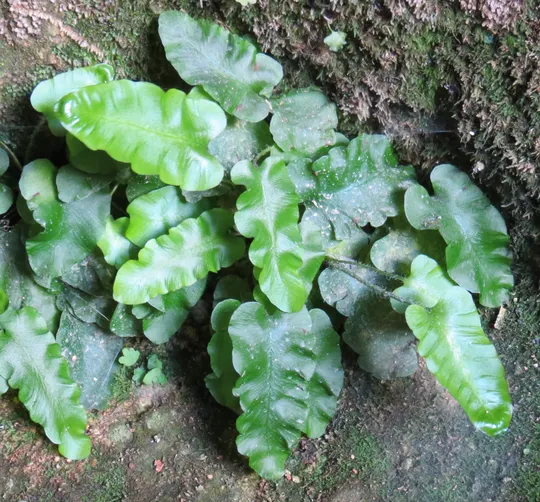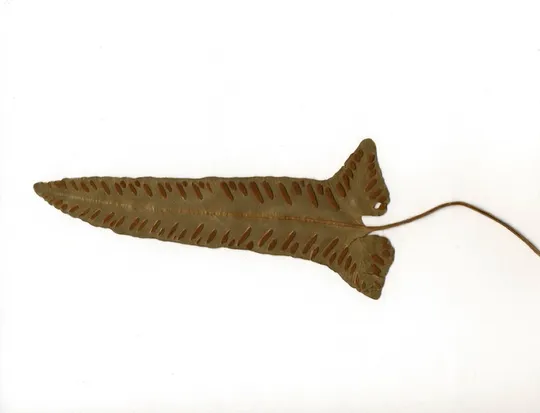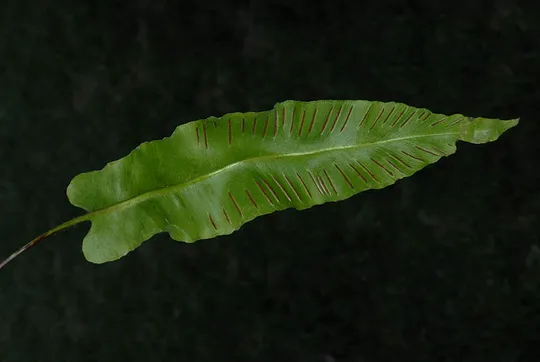Mule's Fern
Asplenium sagittatum


Phyllitis sagittata was known from only a single
site in Israel, at a group of dry water cisterns in Samaria, near the top of Mount Gerizim, 1 km south of Nablus. P. sagittata was observed there annually until 1987. In the late
1990s, following extensive work at the Mount Gerizim summit, the cisterns and
caves that housed P. sagittata populations were
destroyed. Banan al Schekh surveyed the area in 2001 and found that the species had
completely disappeared from the Nablus region and Mt. Gerizim. P. sagittata was believed to have grown on Mount Meron as well, but
it turned out to be Asplenium scolopendrium (Yaffe, 1982).
Cisterns where constant humidity is
maintained throughout the year.
The genus Phyllitis
has eight species that are common in North America, Europe and northern Asia. In recent years, there is a tendency
to combine the genus Phyllitis with the giant genus
Asplenium. Asplenium
has 720 species found in tropical and temperate areas alike. All species of the genus are perennial evergreen herbaceous plants lacking stems, but show a
huge variety of leaf shapes and habitats.
P.
sagittata is very similar to Asplenium scolopendrium from
which it differs in its leaves, whose length is more than four times their
width, and in the shape of its leaf blade that is not triangular and has a
narrow base. Mature leaves are required
for definite identification. The leaf shape of A. scolopendrium is
very variable (Yaffe, 1983). The leaves
of populations in Israel are very variable and polymorphic, as was found in
plants grown from spores from five different sites in Samaria and Judea. The
leaves of plants collected in the southern Hebron hills often have a cordate (heart-shaped)
base (similar to P. sagittata), unlike the characteristic appearance of
the species in Europe, where the base of the leaf is not cordate. Very unusual shapes were collected from the Bani Na’im site, in
which the tip of the leaf splits into three long secondary lobes, which give it
a cross-like shape. P. sagittata
found on Mount Gerizim also displayed leaves with unusual shapes.
On Mount Gerizim P. sagittata and A. scolopendrium grew
together, and hybrid forms were found as well. The leaves of many plants in the
population were huge (size 20-45 cm), and this may have been a polyploid
population. The populations in Samaria are the only ones in the world with
forms that are suspected hybrids between the species. This population is now extinct.
·
A species that became extinct in Israel even
though it was a protected plant. Grew only on a single site.
A thorough search for Phyllitis sagittata
should
be conducted on the summit of
Mount Gerizim. Attempts should be made to
breed populations and reintroduce them to the original site or nearby. In Samaria and Judea at least five dry cisterns were found in which Asplenium scolopendrium, whose habitat is
similar to that of P. sagittata, grows.
Therefore, it is likely
that P.
sagittata can be easily reintroduced to two alternative sites.
Phyllitis sagittata has a broad Mediterranean distribution: in the Middle East it grows on the coastal
mountains in Syria-Lebanon, on the mountains of Lebanon and in Horan (Ǧebel Druz). It
also grows in Turkey and in all
the Mediterranean countries from Spain in the west through Italy, Sicily to Greece in the east, as well as in all the Maghreb countries, including Tunisia and Libya.
Phyllitis sagittata is a fern species that grew on a single site at the
Mount Gerizim summit and is now extinct. Its extinction
emphasizes the need for caution when earthworks are conducted in unique
habitats on rare sites.
יפה, ע. 1983. על הסוג גריזית בארץ. רתם 7: 48-55.
Current Occupancy Map
| 1000 squre meter pixel | 5000 squre meter pixel | 10000 squre meter pixel | |
|---|---|---|---|
| number of observations | 0 | 0 | 0 |
| in total pixels | 0 | 0 | 0 |
| Family | Aspleniaceae |
| Classification | On the endangered species list |
| Ecosystem | Mediterranean |
| Chorotype | Mediterranean |
| Conservation Site | Returning to Mount Gerizim, Nebi Samu'el |
| Rarity |
1
6
6
|
|---|---|
| Vulnerability |
0
3
4
|
| Attractiveness |
0
2
4
|
| Endemism |
0
0
4
|
| Red number |
1
5.7
10
|
| Peripherality | N |
| IUCN category | DD EW EX LC CR EN VU NT |
| Threat Definition according to the red book | Critically endangered |
 Based on:
Based on:






